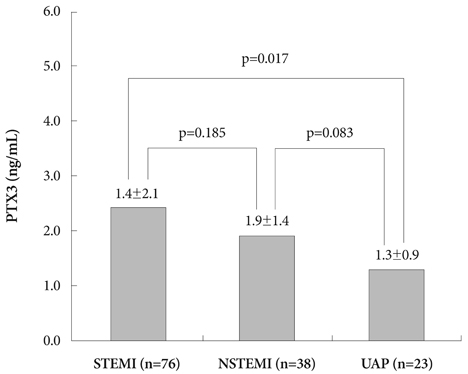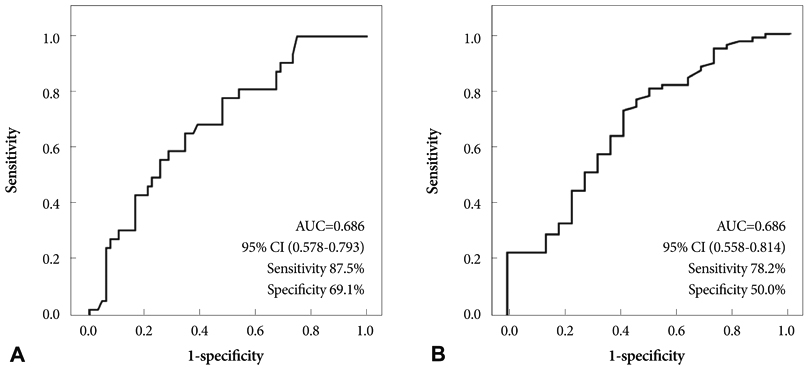Korean Circ J.
2010 Aug;40(8):370-376. 10.4070/kcj.2010.40.8.370.
Pentraxin 3 as a Novel Marker Predicting Congestive Heart Failure in Subjects With Acute Coronary Syndrome
- Affiliations
-
- 1Division of Cardiology, Department of Internal Medicine, College of Medicine, The Catholic University of Korea, Seoul, Korea. jhkmht@catholic.ac.kr
- KMID: 2145528
- DOI: http://doi.org/10.4070/kcj.2010.40.8.370
Abstract
- BACKGROUND AND OBJECTIVES
Pentraxin 3 (PTX3) was shown to be elevated in the acute phase of acute myocardial infarction (AMI) and to have prognostic significance in AMI patients. The aim of this study was to estimate whether the value of PTX3 could be used as a prognostic biomarker, with the global registry of acute coronary events (GRACE) risk assessment tool, in patients with acute coronary syndrome (ACS).
SUBJECTS AND METHODS
Between July 2007 and June 2008, 137 patient subjects (mean age : 61+/-12 years, M : F=108 : 29) with ACS who underwent coronary intervention, but did not have a prior percutaneous coronary intervention (PCI) and/or follow-up coronary angiogram, were enrolled. We estimated the all-cause mortality or death/MI, in-hospital and to 6 months, using the GRACE risk scores and compared these estimates with serum PTX3 concentrations.
RESULTS
The serum PTX3 concentration showed a significant increase in ST segment elevation myocardial infarction (STEMI) greater than the unstable angina pectoris (UAP) group (2.4+/-2.1 ng/mL vs. 1.3+/-0.9 ng/mL, p= 0.017, respectively), but did not show a significant difference between non-ST segment elevation myocardial infarction (NSTEMI) and the UAP group (1.9+/-1.4 ng/mL vs. 1.3+/-0.9 ng/mL, p=0.083, respectively). The serum PTX3 concentration was closely related to death/MI in-hospital (r=0.242, p=0.015) and death/MI to 6 months (r=0.224, p=0.023), respectively. The serum PTX3 concentration was not related to all-cause mortality in-hospital (r=0.112, p=0.269) and to 6 months (r=0.132, p=0.191), respectively. Among the parameters determining the GRACE risk scores, the degree of Killip class in congestive heart failure (CHF) was independently associated with the supramedian PTX3 concentration [odds ratio: 2.229 (95% confidence interval: 1.038-4.787), p=0.040].
CONCLUSION
The serum PTX3 level provides important information for the risk stratification of CHF among the parameters determining the GRACE risk scores in subjects with ACS.
MeSH Terms
Figure
Reference
-
1. Noh HJ, Kwon NH, Joo SB. Severity of coronary atherosclerosis: influence of metabolic syndrome risk factor clustering and hs-CRP. Korean Circ J. 2006. 36:802–808.2. Doo YC, Park WJ, Park SH, et al. The optimal timing to measure C-reactive protein to predict cardiac events in patients with unstable angina. Korean Circ J. 2001. 31:290–296.3. Kim TI, Chae SC, Yang DH, et al. Short-term prognostic value of CRP in the patients with acute coronary syndrome. Korean Circ J. 2000. 30:1387–1394.4. Haverkate F, Thompson SG, Pyke SD, Gallimore JR, Pepys MB. Production of C-reactive protein and risk of coronary events in stable and unstable angina. European Concerted Action on Thrombosis and Disabilities Angina Pectoris Study Group. Lancet. 1997. 349:462–466.5. Rossi E, Biasucci LM, Citterio F, et al. Risk of myocardial infarction and angina in patients with severe peripheral vascular disease: predictive role of C-reactive protein. Circulation. 2002. 105:800–803.6. Rolph MS, Zimmer S, Bottazzi B, Garlanda C, Mantovani A, Hansson GK. Production of the long pentraxin PTX3 in advanced atherosclerotic plaques. Arterioscler Thromb Vasc Biol. 2002. 22:e10–e14.7. Garlanda C, Bottazzi B, Bastone A, Mantovani A. Pentraxins at the crossroads between innate immunity, inflammation, matrix deposition, and female fertility. Annu Rev Immunol. 2005. 23:337–366.8. Peri G, Introna M, Corradi D, et al. PTX3, a prototypical long pentraxin, is an early indicator of acute myocardial infarction in humans. Circulation. 2000. 102:636–641.9. Latini R, Maggioni AP, Peri G, et al. Prognostic significance of the long pentraxin PTX3 in acute myocardial infarction. Circulation. 2004. 110:2349–2354.10. GRACE Investigators. Rationale and design of the GRACE (global registry of acute coronary events) project: a multinational registry of patients hospitalized with acute coronary syndrome. Am Heart J. 2001. 141:190–199.11. Eagle KA, Goodman SG, Avezum A, Budaj A, Sullivan CM, López-Sendón J. Practice variation and missed opportunities for reperfusion in ST-segment-elevation myocardial infarction: findings from the global registry of acute coronary events (GRACE). Lancet. 2002. 359:373–377.12. Granger CB, Goldberg RJ, Dabbous O, et al. Predictors of hospital mortality in the global registry of acute coronary events. Arch Intern Med. 2003. 163:2345–2353.13. Eagle KA, Lim MJ, Dabbous OH, et al. A validated prediction model for all forms of acute coronary syndrome: estimating the risk of 6-month postdischarge death in an international registry. JAMA. 2004. 291:2727–2733.14. Das R, Kilcullen N, Morrell C, Robinson MB, Barth JH, Hall AS. The British Cardiac Society Working Group definition of myocardial infarction: implications for practice. Heart. 2006. 92:21–26.15. Smith SC Jr, Feldman TE, Hirshfeld JW Jr, et al. ACC/AHA/SCAI 2005 guideline update for percutaneous coronary intervention: a report of the American College of Cardiology/American Heart Association Task Force on Practice Guidelines (ACC/AHA/SCAI Writing Committee to Update the 2001 Guidelines for Percutaneous Coronary Intervention). J Am Coll Cardiol. 2006. 47:e1–e121.16. Anderson JL, Adams CD, Antman EM, et al. ACC/AHA 2007 guidelines for the management of patients with unstable angina/non-ST-Elevation myocardial infarction: a report of the American College of Cardiology/American Heart Association Task Force on Practice Guidelines (Writing Committee to Revise the 2002 Guidelines for the Management of Patients With Unstable Angina/Non-ST-Elevation Myocardial Infarction) developed in collaboration with the American College of Emergency Physicians, the Society for Cardiovascular Angiography and Interventions, and the Society of Thoracic Surgeons endorsed by the American Association of Cardiovascular and Pulmonary Rehabilitation and the Society for Academic Emergency Medicine. J Am Coll Cardiol. 2007. 50:e1–e157.17. Antman EM, Hand M, Armstrong PW, et al. 2007 Focused Update of the ACC/AHA 2004 Guidelines for the Management of Patients With ST-Elevation Myocardial Infarction: a report of the American College of Cardiology/American Heart Association Task Force on Practice Guidelines: developed in collaboration With the Canadian Cardiovascular Society endorsed by the American Academy of Family Physicians: 2007 Writing Group to Review New Evidence and Update the ACC/AHA 2004 Guidelines for the Management of Patients With ST-Elevation Myocardial Infarction, Writing on Behalf of the 2004 Writing Committee. Circulation. 2008. 117:296–329.18. Bassand JP, Hamm CW, Ardissino D, et al. Guidelines for the diagnosis and treatment of non-ST-segment elevation acute coronary syndromes. Eur Heart J. 2007. 28:1598–1660.19. King SB 3rd, Smith SC Jr, Hirshfeld JW Jr, et al. 2007 Focused Update of the ACC/AHA/SCAI 2005 Guideline Update for Percutaneous Coronary Intervention: a report of the American College of Cardiology/ American Heart Association Task Force on Practice Guidelines: 2007 Writing Group to Review New Evidence and Update the ACC/AHA/SCAI 2005 Guideline Update for Percutaneous Coronary Intervention, Writing on Behalf of the 2005 Writing Committee. Circulation. 2008. 117:261–295.20. KingSB 3rd, Smith SC Jr, Hirshfeld JW Jr, et al. 2007 focused update of the ACC/AHA/SCAI 2005 guideline update for percutaneous coronary intervention: a report of the American College of Cardiology/American Heart Association Task Force on Practice guidelines. J Am Coll Cardiol. 2008. 51:172–209.21. de Beer FC, Hind CR, Fox KM, Allan RM, Maseri A, Pepys MB. Measurement of serum C-reactive protein concentration in myocardial ischaemia and infarction. Br Heart J. 1982. 47:239–243.22. Verma S, Devaraj S, Jialal I. Is C-reactive protein an innocent bystander or proatherogenic culprit?: C-reactive protein promotes atherothrombosis. Circulation. 2006. 113:2135–2150.23. Scirica BM, Morrow DA. Is C-reactive protein an innocent bystander or proatherogenic culprit?: the verdict is still out. Circulation. 2006. 113:2128–2134.24. Suzuki S, Takeishi Y, Niizeki T, et al. Pentraxin 3, a new marker for vascular inflammation, predicts adverse clinical outcomes in patients with heart failure. Am Heart J. 2008. 155:75–81.25. Kotooka N, Inoue T, Aoki S, Anan M, Komoda H, Node K. Prognostic value of pentraxin 3 in patients with chronic heart failure. Int J Cardiol. 2008. 130:19–22.26. Inoue K, Sugiyama A, Reid PC, et al. Establishment of a high sensitivity plasma assay for human pentraxin3 as a marker for unstable angina pectoris. Arterioscler Thromb Vasc Biol. 2007. 27:161–167.27. Salio M, Chimenti S, De Angelis N, et al. Cardioprotective function of the long pentraxin PTX3 in acute myocardial infarction. Circulation. 2008. 117:1055–1064.28. Kotooka N, Inoue T, Fujimatsu D, et al. Pentraxin3 is a novel marker for stent-induced inflammation and neointimal thickening. Atherosclerosis. 2008. 197:368–374.
- Full Text Links
- Actions
-
Cited
- CITED
-
- Close
- Share
- Similar articles
-
- A Case of Acute Fulminant Myocarditis Progressed into and Recovered from Congestive Heart Failure and Multiorgan Failure
- Bilateral Coronary Artery-Right Ventricular Fistula in Newborn: Associated with Atrial Septal Defect
- Volume Status, a Novel Marker of Contrast Induced Acute Kidney Injury in Acute Heart Failure Undergoing Coronary Angiography?
- A Case of Kawasaki Disease in a 16-year-old Girl Associated with Congestive Heart Failure
- Multicenter Analysis of Clinical Characteristics of the Patients with Congestive Heart Failure in Korea




